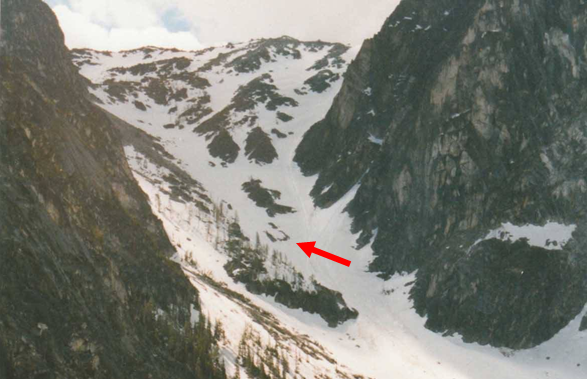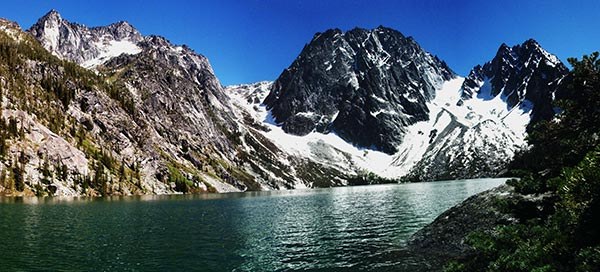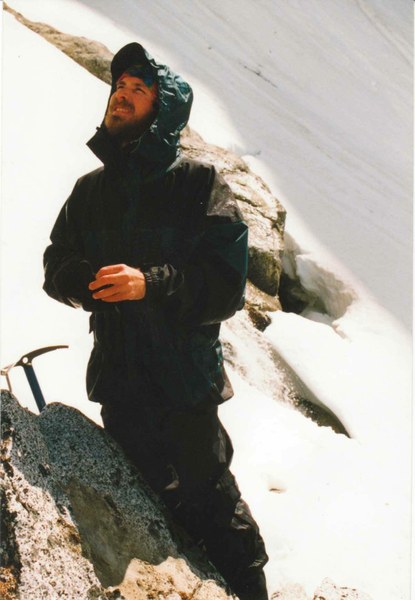
By Steve Smith, Mountaineers Climbing Education Manager
After climbing for over 20 years in the Cascades, I have lived through a few incidents and near-misses. This is the story of how I almost died glissading down Aasgard Pass in the Enchantments.
It was May of 1998 and my partner Blake and I had left our camp at Colchuck Lake bright and early to make an attempt on the West Ridge of Prusik Peak. The snow was firm and light cloud cover made the climb up to the top of Aasgard Pass relatively pleasant for such a long slog. We hiked a few miles over to our objective ridge and my partner decided he was not feeling up for it that day, so we made the decision to let go of our climbing objective and just enjoy the day. Arriving back at the Pass, Blake went rocketing down the now-softening snow in a very fast glissade.
I tend to glissade a bit more carefully, so I hopped into his glissade track and started sliding down the hill towards the lake. I had our climbing rack, food, and water in my pack and my helmet was clipped on the outside of my pack as I slid down the slope.
After descending for hundreds (perhaps a thousand) feet, I was enjoying the ride and Blake had blasted far ahead of me. I could hear the swoosh of the snow and feel the sun on my face. Abruptly, as I passed over a small rise in the slope, everything went dark. And then it was deafening, and wet, and freezing cold, and I couldn’t breathe.
 Assgard Pass and Colchuck Glacier | Photo by Nathan Wiggen
Assgard Pass and Colchuck Glacier | Photo by Nathan Wiggen
What happened?
Still following Blake’s glissade path, I had dropped into a 30-foot deep hole in the snowpack where a waterfall poured over a cliffband, carving a hole in the snow. As I dropped into the hole, I hit my face on the downhill edge of the snow, losing my glasses and stunning myself. I had dropped into a cold, dark chute of freezing cold snowmelt pouring over rock, and wedged into the constriction between the icy snow and the mossy, wet granite rock. I was suspended above a deep, dark hole where the water poured below the snowpack, and was very much wedged in tight with water pouring into my face. I could see the light coming in from the hole I had slipped into, far above me, but I could not get any air.
I found that I could create an air pocket by putting my head down and allowing the water to pour on either side of my head, but that the moment I lifted my head to look around, I was pummeled by the waterfall and could not breathe. It was terrifying and freezing and disorienting, having gone from a pleasant sunny slide down the snow to a loud, freezing, drowning situation where I had to physically battle just to breathe. I thrashed and thrashed but my pack was buckled (both waistbelt and sternum strap) and I was unable to raise my arms enough to unclip myself. I was also afraid that if I detached from my pack, that I would slip further down into the slot and go completely underneath the snowpack, not to be found again until the snow receded months later. It felt like a no-win situation.
As I thrashed and as the water poured over me, I began to shiver and began to relax. I felt myself slip deeper into the constriction and my feet were dangling. I was completely suspended by my pack, and my arms were pinned at my sides. I took some deep breathes and began to slip into a state of acceptance. It was becoming harder to create the air pocket for me to breathe, and to look up towards the light coming in from above. I felt a sense of quiet and peace in the roaring, dark chaos.
Suddenly, I came back and with a sense of terror, realized that I was becoming hypothermic and that if I didn’t act soon, it would be too late. I desperately twisted and thrashed, freeing one of my arms enough to unbuckle my sternum strap. Everything shifted and both arms were free. I unclipped my waist belt and was able to chimney between the snow on one side and the rock/waterfall on the other side. My pack had filled with water and felt like it weighed 200 pounds, so I wedged it in and abandoned it in order to get out of the running water.
Soon, I had slid over to the side, out of the water, and was able to collect myself. My head was pounding from having hit it on the way into the hole, but what I could see gave me some hope. There was a spacious cavern carved out by the water, and several tunnels leading in a few directions. There was also a rock wall leading back up to the light, if only I could climb it.
After collecting myself, I tried to climb the rock wall. It was steep, mossy, wet, and loose, and after going up a way, it simply became blank, slick, and unclimbable in my wet boots. I was afraid that if I fell, I would go so deep into the cavernous hole below that I would never be seen again, so reluctantly I downclimbed back to my air pocket beside the waterfall. There was no way out by going up. I would have to look elsewhere.
I had lost my ice ax in the original fall into the hole, so all I had were my hands to dig with. I put on fleece gloves and started to crawl into one of the tubes. When the tube dead-ended, I began to dig. The snow was firm and consolidated and very well frozen, so my fleece gloves quickly fell apart as I tunneled my way forward. Eventually, a crack of light appeared and I was able to burst through back into the sun, flopping my way out into the bright sunlight about 40 feet downhill from where I had fallen into the hole. I lay there in the sun, soaking wet and freezing but happy to be alive.
What Had Become of my partner?
Blake, in his original glissade, had shot over the waterfall with so much momentum that he actually landed safely on the other side of it. In an attempt to keep me from falling in, he was coming back uphill when I plopped over the crest and disappeared below the snowpack. He had had his own ordeal (cautiously) approaching the hole and trying to figure out how to help me. When I tunneled out downslope, I saw him uphill from me peering and screaming into the hole, but over the sound of the waterfall, he could not hear me downhill from him. It took him awhile to notice me down there, laying in a dazed state on the snow. He was very helpful, providing me with some warm clothes to change into as the first step.
What happened next?
After changing into some warmer clothes and rewarming in the sun, I began to think about my pack and my climbing gear down in the hole and wanted to see if I could somehow retrieve all of that. Since Blake had the rope, and we had some snow protection, we were able to build an anchor and I actually rappelled back down into the slot to retrieve my gear.
 Steve Smith And the Hole he glissaded into | Photo by Blake Larsen
Steve Smith And the Hole he glissaded into | Photo by Blake Larsen
Analysis:
There were several factors that contributed to the incident:
State of mind: We had made the conservative decision earlier in the day not to climb Prusik Peak, as my partner was not feeling up for it that day. Having made the decision not to climb, I believe I slipped into a somewhat lackadaisical and complacent state, and let my guard down to some extent.
Glissade Technique: I was a bit careless in my glissade technique. For example, although I had my ice axe out, my helmet was clipped outside of my pack and I was not wearing gloves. I was also allowing Blake to lead the way and was not paying as much attention to the big picture of where we were going. So again, I was a bit complacent. I also allowed myself to glissade over a ridge when I could not clearly see the runout below. I was also trying to keep up with Blake who was going much faster down the slope than I normally allow myself to glissade.
How hidden the waterfall was: I did go back up the hill, above the waterfall, in the interest of learning from my experience. I was able to get to within a few feet of the waterfall and it was completely invisible from above, and I could not hear anything at all – it was absolutely hidden and entirely muffled by the snowpack. Only once I had completely fallen in could I hear the roaring waterfall. This was a very surprising and useful lesson about how such serious hazards could be so hard to detect even when you know they’re there.
What contributed to my survival:
Luck: Had I been more stunned by the blow to my head, more wedged into the waterfall, less wedged into the waterfall and swept away, or less able to free my arms, I would have become hypothermic and died within minutes. I was very fortunate.
Refusal to give up: When I was becoming apathetic and starting to slip into a state of peace, something inside came roaring back and gave me the power to fight my way out.
Innovation: When I was unable to climb out, I decided to save myself by digging deeper into the snow. This was improbable, but turned out to be the right way to go.
Great Partner: Blake was very helpful in sharing warm clothes to change into once I escaped from the hole, and assisting me with safely retrieving my lost gear.
Key lessons from the incident:
- Never turn off your brain; maintain situational awareness.
- Communicate a clear plan with your partner, and don’t let someone else’s style of ascent or descent create an unsafe style or mindset for yourself.
- Don’t glissade with any momentum into terrain that you can’t visually assess.
- Scope out terrain above you for hidden hazards that you can avoid when descending that same terrain later (the waterfall was very visible from below, though entirely hidden from above)
- Wear your helmet while glissading. It makes a lot more sense than carrying it.
- Wear gloves when glissading. You never know what they might end up protecting you from!
 Steve Smith | Photo by Blake Larsen
Steve Smith | Photo by Blake Larsen
Sadly, too many others have not been so lucky, and Aasgard Pass has been the site of several similar incidents over the years, some of them proving to be fatal. My heart goes out to those who fell into that hidden hole in the snow and unlike me, were unable to escape:
- http://www.wenatcheeworld.com/news/2011/jul/04/hiker-plunges-down-snow-face-on-aasgard-pass/
- http://www.wta.org/news/signpost/staying-safe
- http://www.spokesman.com/stories/2016/jun/06/hiker-vanishes-over-edge-in-alpine-lakes-wildernes/
- https://www.mi-reporter.com/news/mercer-island-man-missing-believed-dead-after-fall-through-snow-at-aasgard-pass/
Editor's Note:
More than just a harrowing story, highlighting Steve's experience has inspired discourse and action on mountain safety. Read oufollow up blog about the impact of this piece.
Add a comment
Log in to add comments.Must read for all who glissade. Shared with Everett Basic Course FB page, Washington Hikers & Climbers and linked kept for next year's new climbers. Thanks, Steve!
Thanks for sharing. I've glissaded a thousand times, not to mention crossed 5x as many snowfields, and always worried about hidden torrents below the snowpack and the thinness of cover. Guess I've been lucky. Good lesson in staying dialed in, even when you think you're in the clear. Had many Basic students over the years frown and go home pissed at me for pulling the plug and playing it safe. Still alive to talk about it :-)
Thanks for your comments on my blog post. It was a harrowing but educational experience and I am glad to be able to share my learning with others.
Thanks very much for sharing this story and your insights. After 40 years of climbing I am taken aback by how newly minted basic and intermediate students immediately revert to the sitting glissade. When I began climbing I was taught that the safe (and cool) thing to do was standing glissades. It assured better control, in all aspects. I've never had a student use this on any of my climbs. I would encourage all climbers/scramblers to become proficient at the standing glissade. It might not have prevented the incident you prescribe--but 'might' have minimized it and provided an opportunity to arrest.
Thank you for this very detailed account of your Aasgard Pass experience. I've only recently learned how to glissade up at Hurricane Ridge here on the Olympic Peninsula because of an attempted Mt. St. Helens summit (which got all fouled up by a bronchitis bug that jumped up out of nowhere). But now my pals and I want to climb up Aasgard Pass in early July and it will be my first time making that attempt. I've always sort of resisted doing Aasgard because of the deaths of people falling into the waterfall holes. I was always curious "what the heck is a waterfall hole and how are people doing that...and how likely is it to live through it?" But now it is more clear of what's going on and I feel a little more at ease and know what to look for. That being said, I'm probably definitely not going to glissading down the pass due to my inexperience lol. I'm glad you made it!
Really glad you're ok. Also I'm glad to have read this before heading into Assguard Pass. So much to learn from this. You have tremendous grit and resilience to get through this.
 Steve Smith
Steve Smith